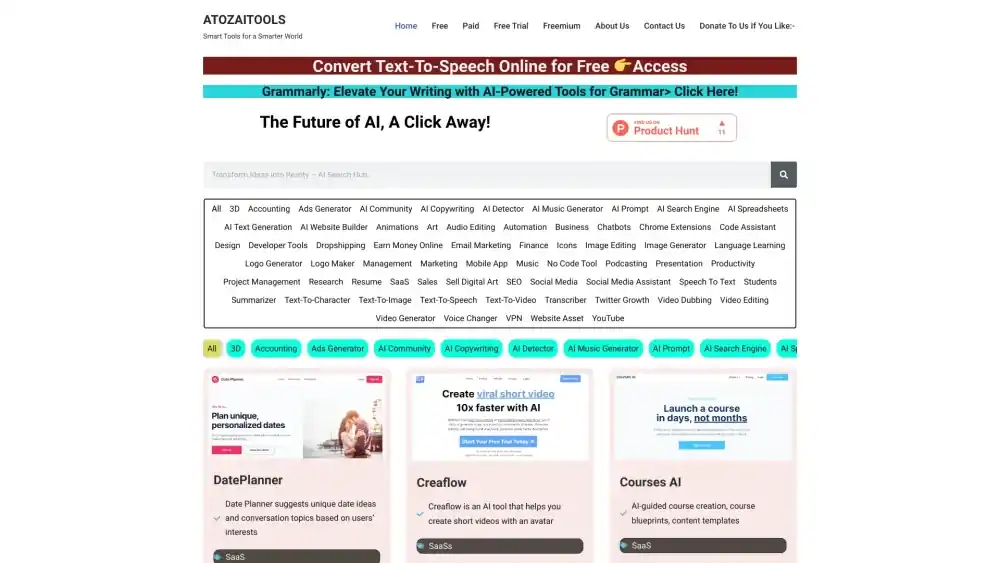Let’s Create a Compelling Introduction for Atozai Tools
Understanding Atozai Tools
Before we dive into crafting the introduction, I’ll need more information about Atozai Tools:
- What does Atozai Tools do? What problems does it solve for users?
- Who is the target audience? Who are you trying to reach with your product?
- What sets Atozai Tools apart? What makes it unique compared to competitors?
- What is the overall tone and style you want to convey? Formal, casual, informative, persuasive?
Possible Introduction Structures
Once we have a clearer picture, we can choose from these introduction structures:
- Problem-Solution: Highlight the problem Atozai Tools solves and introduce it as the solution.
- Example: “Are you tired of managing complex tasks? Atozai Tools is here to simplify your workflow…”
- Benefit-Focused: Emphasize the benefits users will gain by using Atozai Tools.
- Example: “Boost your productivity and efficiency with Atozai Tools. Our powerful features…”
- Feature-Driven: Showcase the key features and functionalities of Atozai Tools.
- Example: “Introducing Atozai Tools, a comprehensive suite of tools designed to…”
- Storytelling: Create a narrative that engages the reader and introduces the product.
- Example: “Imagine a world where managing your projects is effortless…”
Example Introduction (Hypothetical)
Assuming Atozai Tools is a project management tool for small businesses, here’s a possible introduction:
Problem-Solution Structure
“Juggling multiple projects can be overwhelming. Deadlines loom, team members struggle to stay on track, and productivity suffers. Atozai Tools is your solution. Our intuitive platform streamlines project management, improves collaboration, and boosts efficiency.”
Please provide more details about Atozai Tools so I can create a more tailored and impactful introduction.
I look forward to helping you craft the perfect introduction!
Pros and Cons: Weighing Your Options
Pros and cons refer to the advantages and disadvantages of something. By carefully considering both sides, you can make informed decisions.
How to Use Pros and Cons
- Identify the decision: Clearly define what you’re deciding on.
- List pros: Brainstorm all the positive aspects or benefits.
- List cons: Identify potential drawbacks or negative consequences.
- Weigh the options: Compare the pros and cons to determine the best choice.
Example: Choosing a New Job
- Pros: Higher salary, better benefits, opportunity for advancement, interesting work.
- Cons: Longer commute, less vacation time, more responsibilities, new work environment.
Would you like to weigh the pros and cons of something specific? I can help you create a list and analyze the options.
Just provide me with the topic or decision you’re facing.
Pricing: The Art and Science of Value Exchange
Pricing is the process of determining the value that will be exchanged for a product or service. It’s a critical aspect of business strategy, as it directly impacts revenue, profitability, and customer perception.
Key Pricing Considerations
- Cost: Production, distribution, and overhead expenses.
- Competition: Analyzing competitors’ pricing strategies.
- Customer Value: Perceived worth of the product or service.
- Market Demand: Supply and demand dynamics.
- Business Objectives: Profit maximization, market share, or customer acquisition.
Pricing Strategies
- Cost-Plus Pricing: Adding a markup to the product’s cost.
- Value-Based Pricing: Setting prices based on perceived customer value.
- Competitive Pricing: Matching or undercutting competitors’ prices.
- Dynamic Pricing: Adjusting prices based on real-time market conditions.
- Psychological Pricing: Using price points to influence customer perception (e.g., $9.99 instead of $10).
Additional Factors
- Discounts and Promotions: Attracting customers and stimulating sales.
- Price Elasticity: How sensitive customers are to price changes.
- Pricing Strategy Alignment: Ensuring pricing is consistent with overall business goals.
Would you like to explore a specific pricing strategy or discuss a particular product or service?
I can help you with:
- Calculating pricing based on costs
- Analyzing competitor pricing
- Developing value-based pricing strategies
- Creating effective pricing structures
Please feel free to share more details about your business or product.
Let’s Find the Perfect Alternative
To provide accurate and helpful alternatives, please specify what you’re looking for alternatives to.
Here are some examples to get you started:
Products or Services
- Example: “Alternatives to Adobe Photoshop”
- Result: A list of image editing software with their websites.
Websites or Platforms
- Example: “Alternatives to Facebook”
- Result: A list of social media platforms with their websites.
Entertainment
- Example: “Alternatives to Netflix”
- Result: A list of streaming services with their websites.
Activities or Hobbies
- Example: “Alternatives to running”
- Result: A list of physical activities with potential benefits.
Once you provide more details, I can offer tailored suggestions and links.
For instance, if you’re looking for alternatives to a specific product or service, please provide the following information:
- What is the primary function or purpose of the product or service?
- What specific features or qualities are important to you?
- Are there any limitations or constraints to consider?
I’m ready to assist you further once you clarify your request.
Would you like to try rephrasing your query?
FAQs: Your Go-To Information Hub
FAQs, short for Frequently Asked Questions, are a collection of questions and their answers designed to provide quick and easy information to users. They’re commonly found on websites, but can also be used in other formats like emails or documents.
Why Use FAQs?
- Saves time: Users can find answers without contacting support.
- Improves customer satisfaction: Quick resolutions to common issues.
- Reduces support load: Fewer repetitive inquiries.
- Boosts SEO: Well-structured FAQs can improve search engine rankings.
Creating Effective FAQs
- Identify common questions: Analyze customer interactions and support tickets.
- Write clear and concise answers: Use simple language and avoid technical jargon.
- Organize questions logically: Categorize by topic for easy navigation.
- Keep it updated: Regularly review and update FAQs as needed.
Example FAQ Structure
- Introduction: Briefly explain the purpose of the FAQs.
- Question and Answer sections: Clear and concise format.
- Search function: Allow users to search for specific questions.
- Contact information: Provide options for further assistance.
Would you like to create FAQs for a specific product, service, or topic? I can help you brainstorm questions, write answers, or structure your FAQ page.
Conclusion: The Final Chapter
A conclusion is the final part of something, where you wrap up the main points and provide a sense of closure.
Key Elements of a Strong Conclusion
- Summarize main points: Briefly reiterate the key arguments or ideas presented.
- Restate thesis (if applicable): Reinforce the main claim of your work.
- Offer final thoughts or insights: Provide additional perspectives or implications.
- Call to action (optional): Encourage readers to take specific steps.
Examples of Conclusions
- Essay: Summarizes the main arguments and offers a final thought on the topic.
- Speech: Reinforces the key message and leaves the audience with a memorable takeaway.
- Research paper: Restates the thesis, summarizes findings, and suggests areas for further research.
- Story: Provides a sense of closure and resolution for the characters and plot.
Would you like to work on a conclusion for a specific piece of writing? I can help you craft a strong and effective ending.
![]()






